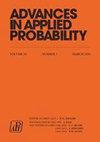带有向边的自排斥随机漫步的局部时间波动
IF 1.2
4区 数学
Q3 STATISTICS & PROBABILITY
引用次数: 0
摘要
2008年,Tóth和vetza将带有向边的自排斥随机行走定义为$\unicode{x2124}$上的非马尔可夫随机行走:在该模型中,行走从$\unicode{x2124}$点移动到给定邻居的概率取决于有向边从初始点到目标点的先前交叉次数,称为边的局部时间。Tóth和vetza发现该模型表现出非常奇特的行为,因为所有边的局部时间形成的过程,在某种类型的停止时间进行评估并适当地重新规范化,收敛于确定性过程,而不是像类似模型那样随机过程。在这项工作中,我们研究了局部时间过程在其确定性极限周围的波动,这是以前所不知道的。我们证明了这些波动在Skorokhod $M_1$拓扑中收敛,以及在远离极限不连续点的均匀拓扑中收敛,但在最经典的Skorokhod拓扑中不收敛。我们还证明了上述停止时间波动的收敛性。本文章由计算机程序翻译,如有差异,请以英文原文为准。
Fluctuations of the local times of the self-repelling random walk with directed edges
Abstract In 2008, Tóth and Vető defined the self-repelling random walk with directed edges as a non-Markovian random walk on $\unicode{x2124}$ : in this model, the probability that the walk moves from a point of $\unicode{x2124}$ to a given neighbor depends on the number of previous crossings of the directed edge from the initial point to the target, called the local time of the edge. Tóth and Vető found that this model exhibited very peculiar behavior, as the process formed by the local times of all the edges, evaluated at a stopping time of a certain type and suitably renormalized, converges to a deterministic process, instead of a random one as in similar models. In this work, we study the fluctuations of the local times process around its deterministic limit, about which nothing was previously known. We prove that these fluctuations converge in the Skorokhod $M_1$ topology, as well as in the uniform topology away from the discontinuities of the limit, but not in the most classical Skorokhod topology. We also prove the convergence of the fluctuations of the aforementioned stopping times.
求助全文
通过发布文献求助,成功后即可免费获取论文全文。
去求助
来源期刊

Advances in Applied Probability
数学-统计学与概率论
CiteScore
2.00
自引率
0.00%
发文量
64
审稿时长
6-12 weeks
期刊介绍:
The Advances in Applied Probability has been published by the Applied Probability Trust for over four decades, and is a companion publication to the Journal of Applied Probability. It contains mathematical and scientific papers of interest to applied probabilists, with emphasis on applications in a broad spectrum of disciplines, including the biosciences, operations research, telecommunications, computer science, engineering, epidemiology, financial mathematics, the physical and social sciences, and any field where stochastic modeling is used.
A submission to Applied Probability represents a submission that may, at the Editor-in-Chief’s discretion, appear in either the Journal of Applied Probability or the Advances in Applied Probability. Typically, shorter papers appear in the Journal, with longer contributions appearing in the Advances.
 求助内容:
求助内容: 应助结果提醒方式:
应助结果提醒方式:


